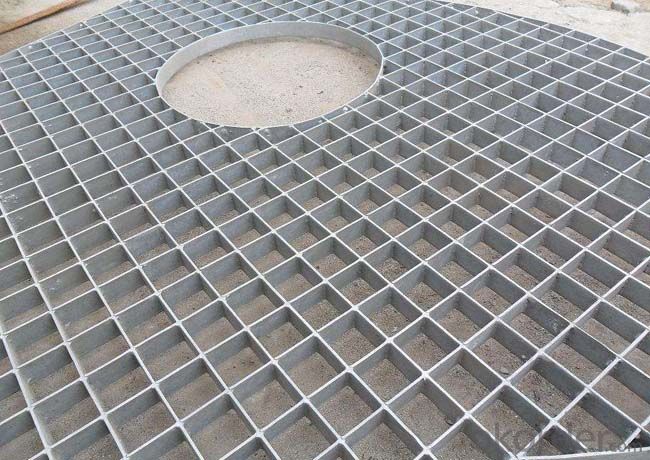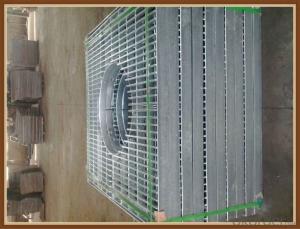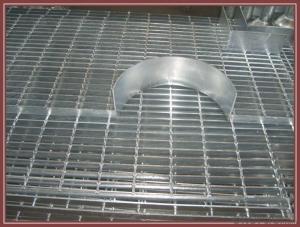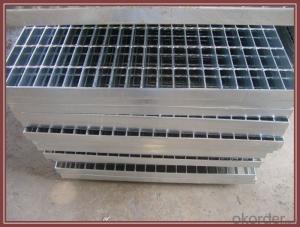Aluminium Grating Stair Tread Carbon Steel Or Stainless Steel
- Loading Port:
- Qingdao
- Payment Terms:
- TT OR LC
- Min Order Qty:
- 5000 pc
- Supply Capability:
- 6000000 pc/month
OKorder Service Pledge
OKorder Financial Service
You Might Also Like
1.Description of Drainage trench cover:
Drainage trench cover is widely used in the urban road, the square, the botanical garden, the wharf, the airport, the parking lot, the road, each kind of industry, the civil project, etc.
2.Main features of Drainage trench cover:
I--Carrying 20 tons of weight
II—Carrying 14 tons of weight
III---carrying 6 tons of weight
IV---carrying 2 tons of weight
V---Carrying pedestrian weight
3.Glass Wool Blanket Images:

4. Drainage Trench Cover Technical Parameters:
These drain cover plate applies to the road cross-sectional and longitudinal drain. The drains width ranging from 200mm to 550mm.
A means the steel grating length
H means the steel grating height
A means the frame length
H means the frame height
5.FAQ
We have organized several common questions for our clients,may help you sincerely:
①How about your company?
A world class manufacturer & supplier of Drainage trench cover is
one of the large scale professional investment casting production bases in China,consisting of both casting foundry forging and machining factory. Annually more than 8000 tons Precision casting and forging parts are exported to markets in Europe,America and Japan. OEM casting and forging service available according to customer’s requirement.
②How to guarantee the quality of the products?
We have established the international advanced quality management system every link from raw material to final product we have strict quality test; We resolutely put an end to unqualified products flowing into the market. At the same time, we will provide necessary follow-up service assurance.
- Q:What is the lifespan of an aluminum sheet?
- The lifespan of an aluminum sheet can vary depending on various factors such as the grade of aluminum, the thickness of the sheet, the environment it is exposed to, and the level of maintenance it receives. Generally, aluminum sheets are known for their durability and long lifespan. Aluminum is a corrosion-resistant metal, meaning it can withstand exposure to moisture and other environmental elements without deteriorating as quickly as other materials. This makes aluminum sheets highly resistant to rust and corrosion, which can significantly extend their lifespan. In general, aluminum sheets can last anywhere from 20 to 50 years or even longer. However, it is important to note that this estimate may change based on the specific application and conditions the sheet is subjected to. For example, aluminum sheets used in outdoor applications, such as roofing or siding, may have a shorter lifespan due to exposure to harsh weather conditions such as UV radiation, extreme temperatures, and heavy rainfall. To maximize the lifespan of an aluminum sheet, proper maintenance and care are crucial. This includes regular cleaning to remove any dirt or debris that can accumulate and potentially cause damage. Additionally, applying protective coatings or treatments can further enhance the sheet's resistance to corrosion and extend its lifespan. Overall, when properly maintained and used in the appropriate applications, aluminum sheets can have a long lifespan, making them a reliable and cost-effective choice for various industries and purposes.
- Q:Are aluminum sheets suitable for food preparation surfaces?
- Yes, aluminum sheets are suitable for food preparation surfaces. Aluminum is a durable and lightweight material that is resistant to corrosion and easy to clean, making it a popular choice for food preparation. However, it is important to note that aluminum can react with certain acidic or salty foods, so it is recommended to use a protective barrier such as parchment paper or silicone mats when working with such ingredients.
- Q:What are the different types of alloys used for aluminum sheets?
- There are various types of alloys used for aluminum sheets, including 1xxx, 3xxx, 5xxx, and 6xxx series. Each alloy has unique properties and characteristics, making them suitable for different applications. The 1xxx series alloys are pure aluminum, while the 3xxx series alloys contain manganese and exhibit good formability. The 5xxx series alloys have magnesium as the primary alloying element and offer excellent corrosion resistance. Lastly, the 6xxx series alloys are known for their combination of strength, formability, and weldability, with magnesium and silicon as their main alloying elements.
- Q:What are the different methods of surface texturing aluminum sheets?
- Aluminum sheets can be textured in various ways, each with its own advantages and applications. 1. Mechanical Texturing involves using mechanical tools or processes, like brushing, sanding, or embossing, to create patterns or textures on the surface of aluminum sheets. This method is commonly used to achieve a matte or brushed finish, enhancing the appearance and concealing imperfections. 2. Chemical Texturing involves using chemicals to etch the surface of aluminum sheets and create unique patterns or textures. Acid etching, for example, selectively dissolves the surface to create a textured effect. This method is often employed to improve adhesive properties, making the sheets suitable for bonding or coating applications. 3. Anodizing is an electrochemical process that forms a controlled oxide layer on the surface of aluminum sheets. It can create various textures, ranging from smooth and glossy to rough and matte. Anodizing not only enhances the appearance but also improves corrosion resistance and durability. It is commonly used in architecture, consumer products, and automotive parts. 4. Laser Texturing utilizes laser technology to create precise and intricate patterns or textures on aluminum sheets. Laser beams can be accurately controlled to remove material or modify the surface, allowing for highly customized and detailed textures. This method is often utilized in high-end applications, such as jewelry, signage, or interior design. Each texturing method offers unique benefits and is suitable for different applications. The choice depends on factors such as desired texture, durability requirements, aesthetic preferences, and intended use of the aluminum sheets.
- Q:How would you write the formula for aluminum sulfate and calcium chloride?
- Aluminium sulfate: Molecular formula Al2(SO4)3·16H2O Calcium chloride: Molecular formula CaCl2
- Q:Can aluminum sheets be used for electrical enclosures?
- Yes, aluminum sheets can be used for electrical enclosures. Aluminum is a popular choice for electrical enclosures due to its excellent conductivity, corrosion resistance, and lightweight properties. It is a good conductor of electricity, allowing for efficient distribution of electrical current within the enclosure. Additionally, aluminum has a high resistance to corrosion, making it suitable for outdoor and harsh environment applications. Its lightweight nature also makes it easier to handle and install. Overall, aluminum sheets are a reliable and commonly used material for electrical enclosures.
- Q:What's the difference between laser cutting aluminum plate and stainless steel plate?
- The aluminum plate is higher than the stainless steel reflectivity, the focal point, the power, the speed are not the same, the general carbon dioxide laser does not have the anti - reflection lens, then had better not cut the aluminum plate, easy to burn the laser internal lens.
- Q:What is the melting point of aluminum sheets?
- The melting point of aluminum sheets is approximately 660 degrees Celsius or 1220 degrees Fahrenheit.
- Q:Carbon costs more than aluminum. But there are manufactures who make high quality alloy frames which costs just as much, if not more slightly than mediocre carbon frames.In your opinion, which is better, stiffer, and lighter?If you need examples....umm like Cervelo's S1 or CAAD9 compared to the lower quality carbon frames.
- A combo of both is nice. But if I had the choice, I would go stiffer frame (aluminum) with carbon stays. For a carbon frame, the carbon has to be decent quality, not like the carbon that is used for making Raleigh frames. Low quality!
- Q:What types of bonds can aluminum form: Covalent, Ionic and/or Metallic?Could you post the source, I've been looking for a while now :/
- Well, any metal can have metallic bonds. Aluminum is a metal and is able to alloy with other metals to modify its properties. The criteria for covalent versus ionic are: (see link 1) If the electronegativities are equal (i.e. if the electronegativity difference is 0), the bond is non-polar covalent. If the difference in electronegativities between the two atoms is greater than 0, but less than 2.0, the bond is polar covalent. If the difference in electronegativities between the two atoms is 2.0, or greater, the bond is ionic. All you need to do is determine the difference in electronegativity to see if the bond is polar covalent or ionic for the compounds of aluminum. The official line is that if a metal and a nonmetal react then the bond is ionic. But, it is not quite that simple. We finally have to look at the difference in electronegativity between the element that make up the compound. Examples: Aluminum oxide Al2O3, aluminum chloride AlCl3 (actually this is Al2Cl6), aluminum fluoride AlF3, aluminum carbide Al4C3. Electronegativity (Pauling Scale): 1.61 for Al Electronegativity (Pauling Scale): 3.44 for O Difference = 1.83 Bond is polar covalent Electronegativity (Pauling Scale): 1.61 for Al Electronegativity (Pauling Scale): 3.16 for Cl Difference = 1.55 Bond is polar covalent Electronegativity (Pauling Scale): 1.61 for Al Electronegativity (Pauling Scale): 3.98 for F Difference = 2.37 Bond is ionic Electronegativity (Pauling Scale): 1.61 for Al Electronegativity (Pauling Scale): 2.55 for C Difference = 0.94 Bond is polar covalent This type of analysis can be done for many other actual compounds of aluminum. Try some yourself. Hope this is helpful to you. JIL HIR
1. Manufacturer Overview |
|
|---|---|
| Location | |
| Year Established | |
| Annual Output Value | |
| Main Markets | |
| Company Certifications | |
2. Manufacturer Certificates |
|
|---|---|
| a) Certification Name | |
| Range | |
| Reference | |
| Validity Period | |
3. Manufacturer Capability |
|
|---|---|
| a)Trade Capacity | |
| Nearest Port | |
| Export Percentage | |
| No.of Employees in Trade Department | |
| Language Spoken: | |
| b)Factory Information | |
| Factory Size: | |
| No. of Production Lines | |
| Contract Manufacturing | |
| Product Price Range | |
Send your message to us
Aluminium Grating Stair Tread Carbon Steel Or Stainless Steel
- Loading Port:
- Qingdao
- Payment Terms:
- TT OR LC
- Min Order Qty:
- 5000 pc
- Supply Capability:
- 6000000 pc/month
OKorder Service Pledge
OKorder Financial Service
Similar products
New products
Hot products
Related keywords































